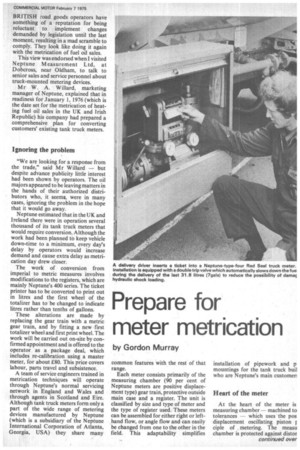Prepare for meter metrication
Page 69

Page 70

If you've noticed an error in this article please click here to report it so we can fix it.
by Gordon Murray
BRITISH road goods operators have something of a reputation for being reluctant to implement changes demanded by legislation until the last moment, resulting in a mad scramble to comply. They look like doing it again with the metrication of fuel oil sales.
This view was endorsed when I visited Neptune Measurement Ltd, at Dobcross, near Oldham, to talk to senior sales and service personnel about truck-mounted metering devices.
Mr W. A. Willard, marketing manager of Neptune, explained that in readiness for January I, 1976 (which is the date set for the metrication of heating fuel oil sales in the UK and Irish Republic) his company had prepared a comprehensive plan for converting customers' existing tank truck meters.
Ignoring the problem
"We are looking for a response from the trade," said Mr Willard — but despite advance publicity little interest had been shown by operators. The oil majors appeared to be leaving matters in the hands of their authorized distributors who, it seems, were in many cases, ignoring the problem in the hope that it would go away.
Neptune estimated that in the UK and Ireland there were in operation several thousand of its tank truck meters that would require conversion. Although the work had been planned to keep vehicle down-time to a minimum, every day's delay by operators would increase demand and cause extra delay as metrication day drew closer.
The work of conversion from imperial to metric measures involves modifications to the registers, which are mainly Neptune's 400 series. The ticket printer has to be converted to print out in litres and the first wheel of the totalizer has to be changed to indicate litres rather than tenths of gallons.
These alterations are made by replacing the gear train with a metric gear train, and by fitting a new first totalizer wheel and first print wheel. The work will be carried out on-site by confirmed appointment and is offered to the operator as a package deal, which includes re-calibration using a master meter, for about £80. This price covers labour, parts travel and subsistence.
A team of service engineers trained in metrication techniques will operate through Neptune's normal servicing network in England and Wales and through agents in Scotland and Eire. Although tank truck meters form only a part of the wide range of metering devices manufactured by Neptune (which is a subsidiary of the Neptune International Corporation of Atlanta, Georgia, USA) they share many common features with the rest of that range.
Each meter consists primarily of the measuring chamber (90 per cent of Neptune meters are positive displacement type) gear train, protective outside main case and a register. The unit is classified by size and type of meter and the type of register used. These meters can be assembled for either right or lefthand flow, or angle flow and can easily be changed from one to the other in the field. This adaptability simplifies installation of pipework and p mountings for the tank truck buil who are Neptune's main customer:
Heart of the meter
At the heart of the meter is measuring chamber machined to tolerances — which uses the pos displacement oscillating piston I ciple of metering. The measu chamber is protected against distor :cause it is completely enclosed by quid at the line pressure. Before aving the works all meters are tested Id calibrated on a test rig using a calirated prover vessel. If not within tolerIce they are returned to the workshop ir re-building.
The piston is the only moving part in le measuring chamber and no liquid in pass through the chamber without :.tuating the piston; therefore displacelent is always positive.
Meters are precision units and should e treated as such. Familiarity breeds 3ntempt and negligence. Most roblems can be traced to a lack of eneral maintenance, filters not being leaned as often as they should be or erhaps not at all; minor adjustments re sometimes ignored and left to evelop into more serious faults. One perator actually removed the filters ltogether to try to increase the rate of ow!
Tank truck builders can help here by laking sure there is adequate space round the meter to allow it to be erviced. I was told of one installation rhich was neatly enclosed to protect the leter from dust and water, but there las insufficient room for the filter to be rithdrawn for cleaning until a hole was ut in the side of the meter cabinet.
Common mistake
A fairly common mistake made by Iperators is to try to re-set the register to ero when the meter is working. Shear iins are built into the register to prevent his, and they cannot be replaced by the )perator — so be warned.
For those operators who wish to wotect their investment Neptune offers service contract which provides a sixnonthly service on the operator's aremises for a fixed charge.
A resident training course in meter operation and routine servicing can also be provided for operators' drivers at the Dobcross works.
In order to ensure optimum performance and long-term metering accuracy, the wetted parts of the meter must be compatible with the liquid, the mete] must be sized to flow rate, and an register and accessories must bt matched to obtain the recording indicating and control function desired.












































































































































